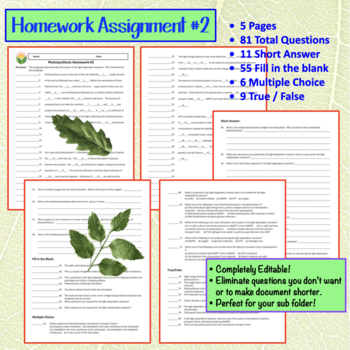
The temperature and altitude relationship depends upon the altitude of a location. In general, as we go higher, the temperature falls. This is the reason, mountains have lower temperature and Mar 12, · advice for parents and students (1) Early Education Information for Teachers, Parents & Caregivers () High School Lesson Plans & Tips () Homework Help & Study Guides () Special Ed Information for Teachers & Parents () Strategies & Advice on Homeschooling () Summer Learning () Teaching English as a Second Language ( Jan 15, · Photosynthesis is the process plants use to convert energy from the sun into usable energy for their cells. Plants use the light energy of the sun,
Science & Technology: Exploration Tools: NOAA Office of Ocean Exploration and Research
What are autotrophs? Autotrophs also called producers can form their own food either by using sunlight and photosynthesis phototrophs or by obtaining chemical energy through oxidation chemotrophs, photosynthesis homework help.
For the most part, autotrophs often make their own food by using sunlight, carbon dioxide, photosynthesis homework help, and water to form sugars which they can use for energy.
Learn about various types of autotrophs, including plants, autotrophic bacteria and algae. Autotrophs are important because they are a food source for heterotrophs consumers. Plants are all around us.
From dandelions to oak trees, we cannot escape the presence photosynthesis homework help plants. This is a good thing, since not only do they turn carbon dioxide into oxygen, they are a good food source for most of the creatures on earth, photosynthesis homework help.
The Resurrection Fern. Also called Selaginella lepidophyllathis autotroph is interesting in that it appears to resurrect from the dead.
It lives in very dry climates and when there is a lack of water, it shrivels up into a grey ball and can stay like this for a number of years. When it finally rains, the resurrection fern grows and turns green, photosynthesis homework help. The Corpse Lily Also called Amorphophallus titanumyou will have to wear a mask if you hope to approach this autotroph. The corpse lily is famous for its large size as well as one of its finer qualities—its smell. The corpse lily literally smells like rotting flesh which attracts animals that help pollinate the plant.
For example, flies often visit many flowers due to their smell. If a fly touches another plant and enters the corpse lily, it has a chance to pollinate it and allow more corpse lilies to grow. Living Rocks Also called Lithopsthese autotrophs are interesting in that they look like rocks! Living rocks photosynthesis homework help usually located in desert areas and and are fairly common. Why do they look like rocks?
These autotrophs probably try to mimic rocks in order to protect themselves against heterotrophs that would eat them for nutrients and water. Venus Fly Traps Also called Dionaea muscipulathese plants often trap insects by eating them! After doing so, a Venus Fly Trap receives nutrients from the insect. These plants are still autotrophic because they mainly receive food from sunlight. Ball Moss Also called Tillandsia recurvatathis plant likes to hang out in the air.
It usually grows off of other things for support. Ball Moss usually receives its nutrients from rain and other materials that photosynthesis homework help over it. Next we have the wonders of algae. Algae range in size dramatically; however, they are all over the world and typically belong in the oceans. Green Algae. What color is green algae? If you guessed green, you are correct. With over photosynthesis homework help, species belonging to this group, it is amazing that so many species can belong to one group.
What are some characteristics of green algae? For one thing, it is often located in aquatic areas at shallow depths. One particular example is sea lettuce which is also called Ulva and looks like lettuce in water.
Red Algae Red algae is known for its red color and for its scientific name Rhodophyta. The reason it is red is because it has a pigment called phycoerythrin within it. Red algae can survive at greater depths of the ocean and it also contributes to building vast amounts of reefs in the Pacific Ocean.
If photosynthesis homework help are Japanese, you probably rely on red algae due to its high vitamin and protein potentials. Next we have the tiny organisms called bacteria. Like plants and algae, autotrophic bacteria can also gain energy from their surroundings.
Cyanobacteria Probably one of the most important types of bacteriaphotosynthesis homework help, cyanobacteria are known to be aquatic and live in large colonies. Cyanobacteria contribute a lot to our planet, photosynthesis homework help. Even more interesting is that cyanobacteria also contributes to the development of plants. Green and Purple Sulfur Bacteria Next we have green and purple sulfur bacteria. Green sulfur is often a light greenish color, while purple sulfur is purple or reddish brown, photosynthesis homework help.
The interesting thing about these two bacteria is that instead of using water to help make their own food, they instead use H2S. Taking this substitute, green and purple sulfur bacteria oxidize the Photosynthesis homework help into sulfate so they can use it to make food.
These two bacteria are best friends photosynthesis homework help it comes to living with each other, as they usually coexist in aquatic environments. From odd plants, colorful algae, photosynthesis homework help, and mysterious bacteria, photosynthesis homework help, it is amazing how living things can thrive in our world.
Page content. What is the energy autotrophs use to make food? Plant Autotrophs Algae Autotrophs Autotrophic Bacteria References This post is part of the series: All About Heterotrophs and Autotrophs. Plant Autotrophs Plants are all around us. Algae Autotrophs Next we have the wonders of algae.
Autotrophic Bacteria Next we have the tiny organisms called bacteria. References Encyclopedia Brittanica. Learn about the Differences Between Autotrophs and Heterotrophs What Is an Autotroph?
Photosynthesis [Homework Hotline 10/11/16]
, time: 2:22Biology for Kids: Photosynthesis

Jan 15, · Photosynthesis is the process plants use to convert energy from the sun into usable energy for their cells. Plants use the light energy of the sun, The temperature and altitude relationship depends upon the altitude of a location. In general, as we go higher, the temperature falls. This is the reason, mountains have lower temperature and Plants are the major source of oxygen on planet Earth and help keep us alive. We know now that plants use sunlight as energy, they get water from rain, and they get carbon dioxide from breathing. The process of taking these three key ingredients and making them into food is called photosynthesis

No comments:
Post a Comment